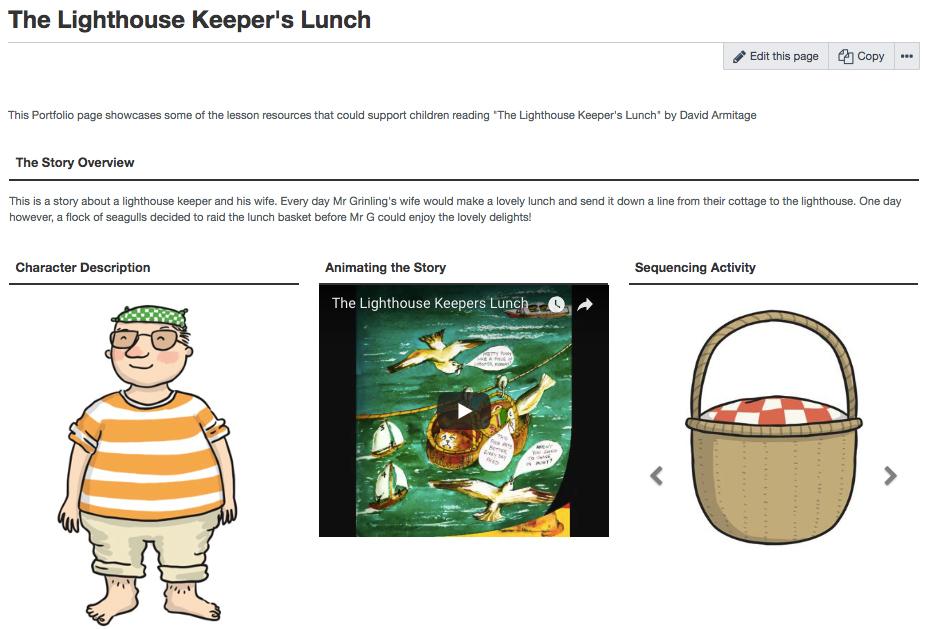
Julie Uí Choistealbha, Aiveen Mullally & Anne McMorrough
‘ePortfolios are student-owned dynamic digital workspaces wherein students can capture their learning and their ideas, access their collections of work, reflect on their learning, share it, set goals, seek feedback and showcase their learning and achievements’ (www.eufolio.eu).
This paper is a showcase of the ways in which ePortfolios form part of the fabric of the work undertaken by staff and students in MIE. The paper concludes with a specific focus on the impact of ePortfolios on teacher’s work. Uí Choistealbha (2018) documents the impact ePortfolios have on students and is a useful reference point when read in conjunction with this paper.
ePortfolios in MIE
The following table provides an overview of the ePortfolio-related input and assessment on each of the programmes delivered in MIE:
Table 1. ePortfolios in Marino Institute of Education.
| Programme | Year | ePortfolio-related Input | ePortfolio-related Assessment |
|---|---|---|---|
| Bachelor in Education (B.Ed.) | 1 | Classroom Communication, Organisation and Management | n/a |
| 2 | Creative Technologies & Inquiry-Based Learning | n/a | |
| 3 | Professional Studies | School Placement evaluations | |
| 4 | Advanced Professional Studies (ASP) | ASP Professional Portfolio | |
| Professional Master in Education (Primary) | 1 | n/a | n/a |
| 2 | Creative Technology Advanced Professional Studies (ASP) | ASP Professional Portfolio |
|
| B.Sc. in Education Studies | 1 | Technology for Teaching and Learning Work Placement | Work Placement Portfolio |
| 2 | Second Language Teaching & Learning Work Placement | Language Learning Portfolio Work Placement Portfolio |
|
| 3 | Studying Teaching Work Placement | Studying Teaching Portfolio Work Placement Portfolio |
|
| 4 | Internship | Internship portfolio + showcase presentation |
The following programmes do not include ePortfolio-related content/ assessment at present: The B.Sc. in Early Childhood Education, The Professional Diploma in Education (Further Education) and the Master in Education Studies Programmes.
Showcases of the use of ePortfolios in MIE
a) Advanced School Placement Professional Portfolio
All final year initial teacher education students in MIE, in line with the recommendations of the Teaching Council (2011), are required to complete an ePortfolio detailing their experience on their extended school placement. The portfolio is a pass/fail element of the final school placement grade. The following elements are to be included:
During Teaching Block 1 and 2:
- A pre-placement video detailing personal goals for self-development and improvement
- A multimedia overview of the school and local community – to be completed during the orientation period.
- One reflection per teaching week (seven in total). Word count should be 250‒500 words or equivalent. Students are to self-select their own area for reflection based on what is emerging for them in any given week.
During the School-based Activity Block & Learning Support/ Resource Week:
- School-based Activity Block Plan
- Plan for Learning Support/ Resource Block
- Reflective video outlining hopes and fears
- One reflection per week (three in total). Word count should be 250‒500 words or equivalent. Students are to self-select their own area for reflection based on what is emerging for them in any given week.
- A multimedia overview of the activities engaged with/tasks completed
b) Studying Teaching Portfolio
Third year B.Sc. in Education Studies students are required to present an ePortfolio as part of their 15 ECTS Studying Teaching module. This involves the design of a portfolio that demonstrates the use of multiple perspectives to analyse their understanding and beliefs about teaching and the study of teaching. Portfolios must contain 10 reflective entries that are directly linked to theoretical frameworks, assigned readings and/or multimedia representations discussed in lectures and tutorials e.g. video, lesson plans, student work/exemplars, teaching materials. Also to be included in this as an 11th entry is a short statement outlining the students’ personal philosophy of teaching.
c) Second Language Teaching and Learning Portfolio
The Second Language Teaching and Learning Portfolio is the most recent portfolio to be introduced in MIE. It was introduced as a result of the Erasmus+ funded project Empowering ePortfolio Process (EEP) (https://eepeu.wordpress.com) in order to extend students exposure to ePortfolios and to develop the use of ePortfolios as a mechanism for providing feedback to students. This approach to feedback was presented in the workshop ‘From workspace to showcase – Using an ePortfolio to provide formative feedback to students’ at the EEP training week in IPS Setubal in Portugal in March 2017 (https://eepeu.wordpress.com/events/building-ownership-of-students-empowering-assessment-and-guidance-methods). The ePortfolio includes an auto ethnographical account of language learning, a multimedia overview of the language learning process, responses to three readings from the module, a presentation (PowerPoint or Prezi) on a language learning context of choice and a personal reflection on feedback from the in class presentation on a language learning context of choice.
The ePortfolio constitutes 100% of the assessment for this 5 ECTS module in second year of the B.Sc. in Education Studies programme.
d) Work Placement Portfolio
Work placement on the B.Sc. in Education Studies programme (years 1‒3) is a valuable opportunity to experience professional settings in education, in which students develop important skills for the workplace by allowing students to apply theory to practice. It also offers employers access to highly motivated students and the students benefit by gaining hands-on experience and a chance to explore career options. The assessment involves all students completing an ePortfolio when on work placement. This multimedia portfolio includes:
- a personal dimension ( goals, aims, personal statements),
- a professional dimension ( CV, work plan, provider information),
- an academic dimension ( link to modules and readings),
- a reflective dimension ( feedback from WP mentors)
- a skill/ competency dimension ( development of communication, problem solving, leadership/ initiative, applied knowledge, teamwork and organisational skills).
Students are required to engage with reflective processes with a view to enhancing their development and to embrace the multimedia potential of ePortfolio, and in doing so synthesise their work- based and college-based learning. The work placement portfolio is the chosen pilot project for MIE’s engagement with the Erasmus+ funded EEP project (https://eepeu.wordpress.com).
e) Internship Portfolio and showcase
The Internship module in 4th year of the Education Studies degree course provides students with an opportunity to gain a meaningful period of work experience in an organisation within the broad education sector over an 8/10 week period. The students organise their own internships based on their individual preferences and career plans. They are required to apply the theoretical concepts and skills acquired during their degree programme over the course of their internship. The internship is assessed through the presentation of an ePortfolio which accounts for 25% of their final degree mark.
Students are encouraged to use the ePortfolio as a vehicle to demonstrate their own learning journey through the internship, including their challenges and achievements. They also have the opportunity to demonstrate how and when they used the core competencies at the heart of the internship module, such as communication skills, leadership, initiative, teamwork, problem solving, decision making and applied knowledge.
The ePortfolio allows the students to demonstrate the higher order skills of synthesising and evaluating what they have learned over the course of almost four years. It offers a space for reflective practice and critical analysis of the internship experience. Mahara allows for a creative, multimedia approach to presenting ideas and the students are encouraged to exploit this in the production of their ePortfolios. The content of the professional ePortfolio can contain:
- General information on the placement provider and insights into how the provider organisation operates
- Specification of roles, responsibilities and tasks for the placement period
- Fortnightly reviews of challenges, successes, key learning
- Examples of implementation of key workplace skills
- Report by designated person in host organisation
- Feedback from colleagues, supervisor and mentor
- Reflection and critical analysis of their own self-assessment
- Impact of internship experience on career plans
Assessment of Internship and ePortfolio: The Showcase
Each student has an opportunity to showcase the highlights of their ePortfolio to an assessment panel. This is a professional presentation, submitted and orally defended to a panel of assessors. The assessment is based on a combination of the ePortfolio and oral Showcase, 80% of which is allocated to three grade descriptors relating to the internship experience and the ePortfolio product, and the remaining 20% for the oral Showcase.
The ePortfolio content is examined based on four main criteria, the first three of which are marked via the portfolio itself:
- The depth and range of experience and level of engagement of the student with the internship process and the degree to which five core competencies are exhibited
- Synthesis of learning from the four years of course content, and level of reflection on the student’s personal and professional learning journey now and into the future
- The portfolio as a coherent, comprehensive, innovative multi-media compilation that describes the totality of the internship journey
- An oral Showcase of the highlights of the portfolio and personal internship experience
The students are given twenty minutes to present the highlights of the ePortfolio to a panel of assessors. It is an opportunity for the students to exhibit and display their personal and professional learning over the four years of the programme through the lens of the internship. Fifteen minutes are then allocated for questions and discussion with the panel of assessors. The Showcase has the potential to demonstrate a variety of media and learning styles.
Supporting the use of ePortfolios in MIE: Student-focused
Recent literature outlines the affordances of using ePortfolios to showcase a rich picture of student learning and competencies through the development and use of multimedia technology skills (Brazdeikis & Valineviciene 2015). At MIE, we embrace this opportunity and gradually evolve the process over three inter-connected stages:
Stage 1) Navigating the ePortfolio platform
At this introductory stage, an ePortfolio platform such as Mahara can be quite daunting for some students. For that reason, through face-to-face workshops in our IT Laboratory, students are gradually familiarized with the basic features of Mahara and given opportunities to experiment. For example: they learn how to personalize their ePortfolio and/or invite friends with whom they may collaborate on future projects, in much the same way as they might do on social media platforms like Facebook. Arguably, when students feel comfortable with how a digital tool such as Mahara works, they will use more fluidly and creatively. In addition to these campus-based workshops, students are provided with off-campus support through a series of short YouTube videos created by the Director of IT and eLearning, as well as materials hosted on an in-house Virtual Learning Environment (Moodle).
Stage 2) Experience in the use of various digital file formats
The second stage of the process aims to build on the basic navigation skills that the students have already learned and introduce them to a range of digital file formats which can enhance their ePortfolio. For example, they learn how to upload digital images, documents, audio and video files to the platform. While the actual process of adding these files to an ePortfolio is relatively straightforward, the space they take up can become problematic over time, especially when each student is limited to 50MB of storage. As a way around this obstacle, students collaboratively learn additional skills. For example, they learn how to reduce the file size of eg a digital image using a free online tool such as Cut My Pic or how to add their video to YouTube/Vimeo and embed it on their ePortfolio instead of uploading it directly. Initially when students begin to explore these workarounds, they sometimes find them challenging as each new skill contains a number of steps. However, through practice the students not only learn the new skills quickly, but also realize how versatile they can be in building an ePortfolio.
3) Creative experimentation of external multi-media platforms.
The third stage of the process is all about “MashUp”! This means that the students are encouraged to pull together the threads of their IT skill-set to combine various forms of data and media in creative ways. Here, for example some students bring together images, video and narrative writing to showcase a School/Work Placement experience in an interesting way. Other students opt to create some digital artifacts outside their ePortfolio platform using a broader range of tools such as TES Blendspace, GlogsterEDU, Padlet, Animoto for Education or BookCreator. One of the affordances of using additional multimedia tools is that they can be directly embedded into an ePorfolio without using up unnecessary space. Nevertheless, when embedding is not supported on an ePortfolio platform, students can simply add a link to their artefact, along with a screenshot, for a similar result. Either way, this process of “mashing up” and experimenting with different kinds of digital tools is a very rewarding one for the students. Figures 1 and 2 are examples of work created by the students.


Research shows that from a technological perspective, an ePortfolio system not only needs to be “reliable, secure, resilient and flexible”, but must also allow for student exploration so that skills may be developed and expanded over time (EUfolio 2015, 18). At MIE, our scaffolded approach to developing and utilizing digital skills within the context of ePortfolios is simple to follow, yet rich in opportunities for creativity and innovation.
MIE framework for supporting the use of ePortfolios: Teacher-focused
The authors of this paper are all directly involved with the use of ePortfolios as showcased above. Based on our own experience as teachers, and the anecdotal reports of colleagues, we have collated a list of words and phrases that teachers associate with ePortfolios. They are grouped under five main headings:
- Meaning
- Autonomy
- Growth
- Impact
- Connection
This can be summarised by saying that ePortfolios need to be MAGIC! (The MAGIC principle is inspired by the work of Ollerton (2016)). The words and phrases in each row of the table below make reference to how teachers anecdotally describe the challenges and benefits of using ePortfolios in a HEI. It can also be read as a list of what teachers need in order to be able to successfully implement and embed ePortfolios in their work.
Table 2. Teacher reflections on ePortfolios.
| Meaning | Sense of purpose How to use it A powerful tool A way to reflect It’s interactive It’s a platform It encourages innovation | You can be creative What is possible with it? It’s like an iceberg It’s to be discovered There’s a need for a common purpose Attributes can be recorded It needs a context We need to be encouraged |
| Autonomy | It is an individual pursuit Work is self-directed Attitude Engagement Ownership Motivation | Foundations are necessary Author must be self-aware Open mind-set is needed Stereotypes (‘techie’) Change management Privacy is important |
| Growth | Training is needed Development is possible Mentoring is needed Guidance is needed | Support is needed Upskilling is necessary CPD opportunities |
| Impact | Dissemination Open form of sharing Assessment of learning Reflection on learning Skills and competencies made visible Showcasing of work | Synthesis of learning Workspace for learning Feedback possible Repository of learning Equality amongst learners Opportunities for learning Learning styles catered for |
| Connection | Language of portfolios Expectations of HEI Need for connectivity between tasks/ lecturers/ subjects Needs to be embedded in practice | Is it an optional extra? Dialogue opportunities Safe space to work Culture in which to embed Priorities of the HEI |
Concluding discussion
There is now a greater awareness of how pedagogic practices impact on student learning, motivation and engagement and a definite move away from the traditional notion of teaching as an exchange of information (OECD, 2012). Westbrook et al. (2013) identified that pedagogic practice is developed through interaction between teachers’ thinking or attitudes, what they do in the classroom and what they see as the outcome of their practice. Pedagogic practices in HEIs are often characterised by the pursuit of knowledge (Hamlyn, 1996) but Brown et al (2011) drawing on the work of Fry et al (1999) Biggs and Tang (2007) show how there is a continuum in HEI pedagogic practices from lectures delivered to the masses in large lecture halls to more problem-based and project-based learning using flexible approaches such as online and web-based i.e. ePortfolios.
As seen earlier in this paper, students have a very structured enculturation into the use of ePortfolios from a technological perspective. However, a recent study on student perspectives of ePortfolios in MIE (Uí Choistealbha 2018) found that students wanted more college-wide supports embedded in their whole learning experience. This places an onus on the institute to ensure that staff are able to provide these support structures. As shown in the table above, teachers too grapple with the concept of ePortfolios from both a conceptual, theoretical, practical and technological perspectives. In order for ePortfolios to have meaning for teachers, it needs to have a purpose within the context they are working. Poortinga and Meeder (2007) state that generally learning environments are not fully developed enough to support the meaningful development of ePortfolios. A recommendation of this paper is that HEIs need to address the learning environment that supports teachers in the embedding of ePortfolios in practice. Without true meaning in context, teachers will struggle to be autonomous in their use of ePortfolios, struggle to grow in their use of ePortfolios, struggle to have impact and struggle to provide those important connections between theory and practice. A next step for MIE will be to provide opportunities for staff to begin to look at creating their own ePortfolios so as to experience the meaning, autonomy, growth, impact and connections that can result from engaging authentically with ePortfolios. All it takes is a bit of MAGIC!

This article was produced in the Erasmus+ (KA2 action) funded project “Empowering Eportfolio Process (EEP)”. The beneficiary in the project is Häme University of Applied Sciences (FI) and the partners are VIA University College (DK), Katholieke Universiteit KU Leuven (BE), University College Leuven-Limburg (BE), Polytechnic Institute of Setúbal (PT) and Marino Institute of Education (IE). The project was implementated during 1.9.2016–30.11.2018.
Authors
Julie Uí Choistealbha, Ed.D., is a senior lecturer and Director of Undergraduate Studies in Marino Institute of Education. Her research interests include work-based learning for students of education, the assessment of work-based learning, the use of ePortfolios in competency- based assessment, programme design and school/university partnerships. Julie is a Trinity College Research Fellow in the School of Education’s Research in School Education (RISE) research group.
Dr Aiveen Mullally is a Lecturer in Marino Institute of Education and coordinates the degree in Education Studies. She has a doctorate in Education and her research interests are in the area of religious diversity and pluralism in schools. She coordinates work placements for students and works with them on creating e-portfolios for their work placements and for their final year assessment
Dr Anne McMorrough is a Lecturer in Education at Marino Institute of Education where she teaches on undergraduate and post-graduate modules that include Inquiry Based Learning and Creative Technologies in the Classroom; Creative Technologies for Teaching and Learning and Classroom Organisation and Communication. Her research explores the changing nature of European education policy; the affordances of digital technologies in education; and creativity / innovation in primary classrooms and early education settings.
References
Biggs, J., & Tang, C. (2007). Setting the stage for effective teaching. Teaching for quality learning at university, 31–59.
Brazdeikis, V. & Valineviciene, G. (2015). Review of Existing ePortfolio Policies and Practices. Retrieved 18 September 2018 from https://eufolioresources.files.wordpress.com/2015/03/d-8_eufolio_policy_practice_review_summary_en.pdf
Brown, M., Withers, E., Down, C., Figgis, J., & McManus, J. (2011). Pedagogical practices across the tertiary sector: Summarising the literature on the pedagogical support for students moving from VET into Universities. Australian Vocational Education and Training Research Association Conference, Melbourne.
Egan, A., FitzGibbon, A., & Oldham, E. (2015). Using ePortfolios in a College of Education – an interim report. In D. Rutledge & D. Slykhuis (Eds.), Proceedings of SITE 2015–Society for Information Technology & Teacher Education International Conference (pp. 1811–1817). Las Vegas, NV, United States: Association for the Advancement of Computing in Education (AACE). Retrieved 18 May 2018 from https://www.learntechlib.org/primary/p/150245
EUfolio (2015). ePortfolio Implementation Guide for Policymakers and Practitioners. Retrieved 18 May 2018 from https://eufolio-resources.eu/school-unit/recommendations/
Fry, H., Ketteridge, S., & Marshall, S. (1999). Understanding student learning. In H. Fry, S. Ketteridge, & S. Marshall (Eds.) A handbook for teaching and learning in higher education, London: Kogan Page.
Hamlyn, D. W. (1996). The concept of a university. Philosophy, 71(276), 205‒218.
OECD ( 2012) Teaching Practices and Pedagogical Innovation Evidence from TALIS . Retrieved 18 May 2018 from http://www.oecd.org/education/school/TalisCeri%202012%20(tppi)–Ebook.pdf
Ollerton, S. (2016) Five Keys to Unlock the Power of Employee Engagement. Retrieved 18 May 2018 from https://www.decision-wise.com/infographic-magic-five-keys-to-unlock-the-power-of-employee-engagement
Poortinga, J., & Meeder, S. (2007). The use of ePortfolios within academic programs. European Institute for E-Learning (EIfEL), 97.
Teaching Council (2011). Initial teacher education: Criteria and guidelines for programme providers. Maynooth: Teaching Council.
Uí Choistealbha, J. (2018) The benefits and challenges of using ePortfolios. In I. Kunnari & M. Laurikainen (eds.) Students’ perspectives on ePortfolios. HAMK Unlimited Journal 31.1.2018. Retrieved 18 May 2018 from https://unlimited.hamk.fi/ammatillinen-osaaminen-ja-opetus/the-benefits-and-challenges-of-using-ePortfolios
Westbrook, J. (2013). Pedagogy, curriculum, teaching practices and teacher education in developing countries. Final report. Education rigorous literature review. Retrieved 18 May 2018 from https://pdfs.semanticscholar.org/6e4c/4b170c0d387addc4157c5f4e39a8b694b2fa.pdf





